When we look at tires, we often see markings and numbers that baffle us. Among these mysterious codes, you might have spotted things like 87t, 87s, 87q, 87h, 87r, 87v, or 87w. But fear not, dear reader, today, we’re unraveling the enigma behind these cryptic tire codes and shedding light on their meaning. Fasten your seatbelt, and let’s ride into the world of tire lingo!
What does 87t, 87s, 87q, 87h, 87r, 87v, 87w mean on a tire?
The mysterious numbers and letters on tires aren’t the work of tire elves playing tricks on us. Instead, these codes represent a tire’s load index and speed rating, a standardized system used by manufacturers worldwide. In simple terms, the numerical part stands for the load index or the maximum weight the tire can carry, while the letter signifies the speed rating or the top speed the tire can handle. Let’s decode this information into a handy table:
| Index and Symbol | Speed Rating | Maximum Speed (Km/h) |
| 87H | High Speed | 210 km/h |
| 87W | Very High Speed | 270 km/h |
| 87V | Very High Speed | 240 km/h |
| 87T | Touring Speed | 190 km/h |
| 87Y | Very High Speed (All Season) | 300 km/h |
| 87S | Standard Speed | 180 km/h |
| 87Q | Standard Speed (Winter tires) | 160 km/h |
What does 87T mean on a tire?
When we see ’87T’ on a tire, it means that the tire can carry a maximum load of 545 kilograms at a top speed of 190 Km/h. But don’t just rush out yet to test your tires at 190 Km/h! Speed ratings aren’t an encouragement to break the speed limit but a safety measure, ensuring that the tire can handle the heat and conditions at high speeds.
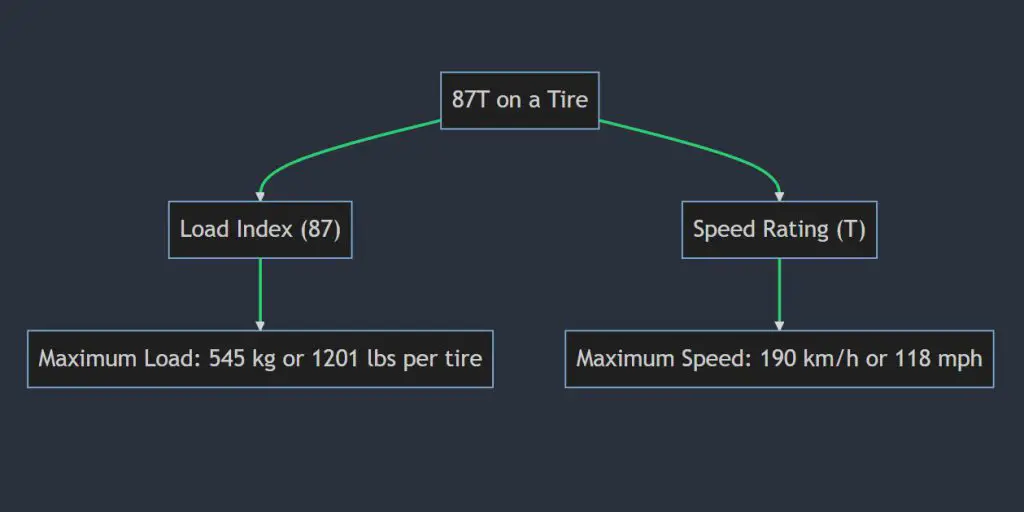
Specifics about 87T Tires
The world of 87T tires is one filled with durability and balance. With a strong focus on offering a dependable and secure ride, these tires are common among compact cars and sedans.
Typical Use Cases for 87T Tires
87T tires shine in everyday, urban environments. They’re ideal for commutes to work, trips to the grocery store, or drives to the movies.
Vehicles Suitable for 87T Tires
Vehicles that commonly use 87T tires include compact and mid-size cars like Honda Civic, Ford Focus, and Toyota Corolla, to name a few.
Precautions when Using 87T Tires
Even though 87T tires have a good speed rating, it’s important to remember to drive responsibly and within speed limits.
FAQ’s
1. Can I replace my 87T tires with a different speed rating?
You can replace them with tires of a higher speed rating, but it’s not recommended to go lower. Always check with your vehicle manufacturer or a tire professional first.
2. Can 87T tires handle snowy conditions?
The 87T rating only relates to load and speed. For snowy conditions, you’d want to look at winter tires with the right tread patterns and rubber compounds.
What does 87S mean on a tire?
An 87S tire can support a load of 545 kilograms and is rated for a maximum speed of 180 Km/h. This speed rating indicates that the tire can maintain its integrity and perform safely at speeds up to 180 Km/h.
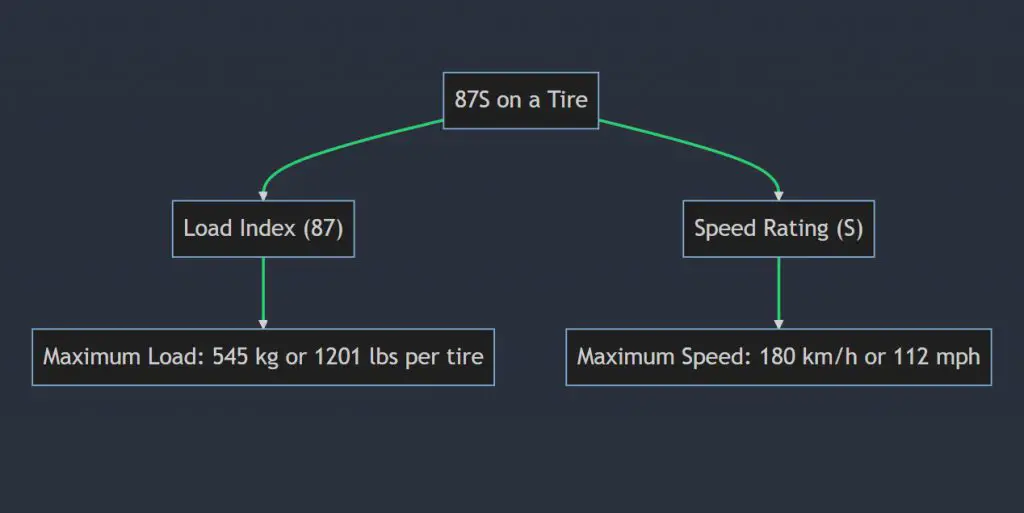
Specifics about 87S Tires
Built with the quintessential combination of performance and durability, 87S tires are a popular choice among motorists who prioritize safety and comfort in their daily drives.
Typical Use Cases for 87S Tires
Like their 87T counterparts, 87S tires are perfect for daily driving scenarios – whether it’s picking up kids from school or taking a weekend trip to the countryside.
Vehicles Suitable for 87S Tires
Cars such as the Hyundai Elantra, Kia Soul, and Chevrolet Malibu commonly come fitted with 87S tires.
Precautions when Using 87S Tires
As always, remember to maintain your tires properly – check for correct inflation, regular rotation, and monitor tread wear.
FAQ’s
1. Can I mix 87S and 87T tires on my car?
It’s generally recommended to have the same type of tires on all four wheels for balanced handling and safety.
2. How long do 87S tires usually last?
Tire longevity depends on a variety of factors, including driving habits, road conditions, and tire maintenance. However, on average, you might expect anywhere from 60,000 to 80,000 km from a set of good-quality 87S tires.
What does 87q mean on a tire?
Picture this: You’re inspecting your tire, and your eyes lock onto a mysterious code – 87q. What in the world of carburetors and camshafts does that mean? Fear not, dear motorist! That’s why I’m here. In the realm of tire-speak, ’87q’ stands for the load index and speed rating of your tire.
The ’87’ means the tire can support a load of up to 545 kilograms, and the ‘q’ indicates that the tire is rated for a maximum speed of 160 Km/h. It’s essential to remember that these numbers and letters are not casual suggestions but rather stern, safety-related regulations from your tire’s maker.
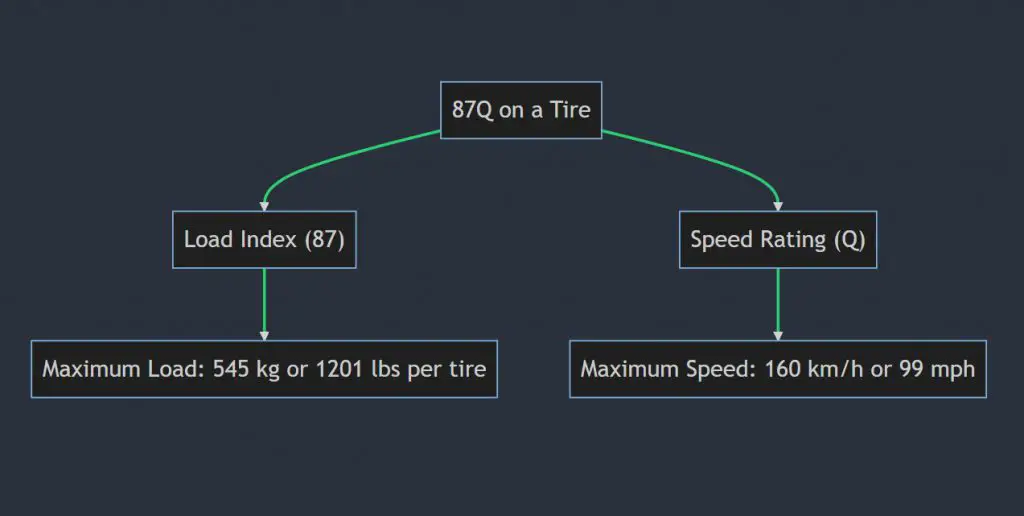
Specifics about 87q Tires
Welcome to the domain of 87q tires, where the road meets resilience. These tires are known for their durability and stability, providing a safe and secure drive even in challenging conditions.
Typical Use Cases for 87q Tires
These tires are not speedsters, so you won’t find them on race tracks. Instead, 87q tires are perfect for everyday driving situations, especially in areas with moderate speed limits.
Vehicles Suitable for 87q Tires
87q tires are typically found on small to mid-sized vehicles, such as the Ford Fusion, Hyundai Sonata, and Volkswagen Passat, owing to their balance between load capacity and speed rating.
Precautions when Using 87q Tires
Never forget to keep a regular check on tire pressure and tread wear. Always ensure to drive within speed limits to ensure the longevity of your 87q tires.
FAQ’s
1. Can I use 87q tires on a high-speed highway?
While it’s technically possible, it’s not advisable due to the tire’s maximum speed rating of 160 Km/h.
2. How often should I replace my 87q tires?
Tire replacement depends on various factors, including driving conditions and maintenance. It’s best to consult with a tire professional.
3. Can I mix 87q tires with other speed ratings?
It’s generally recommended to use the same type of tires on all wheels for balanced handling and safety.
What does 87h mean on a tire?
Seeing ’87h’ on a tire isn’t an enigmatic sign from the universe. Quite simply, the ’87’ in 87h refers to the tire’s load index, meaning it can carry up to 545 kilograms. The ‘h’, on the other hand, is the speed rating, denoting the tire can safely handle speeds up to 210 Km/h. The next time you spot an 87h tire, give it a nod of recognition!
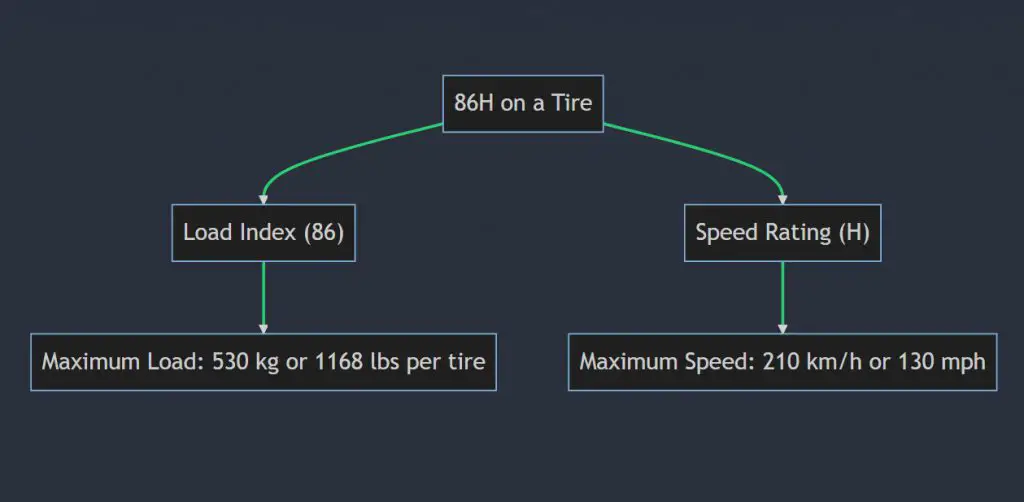
Specifics about 87H Tires
Dive into the world of 87H tires – a place where balance between speed and weight capacity reigns supreme.
Typical Use Cases for 87H Tires
87H tires are perfect for everyday use – be it city driving or highway cruising. Their balanced speed rating allows them to handle a variety of driving conditions with ease.
Vehicles Suitable for 87H Tires
Mid-sized sedans and crossovers like the Honda Accord, Subaru Outback, and Ford Escape are common vehicles that use 87H tires due to their load-bearing capacity and speed rating.
Precautions when Using 87H Tires
Maintain your tires well. Check the tire pressure regularly, and don’t forget to get them rotated and balanced.
FAQ’s
1. Can I use 87H tires for off-roading?
Not really. 87H tires are designed for road use. For off-roading, consider specialized tires with appropriate tread patterns and construction.
2. Can I replace my 87H tires with a higher speed rating?
Yes, but make sure your vehicle’s manufacturer approves this. It’s best to consult with a tire professional.
3. Is the tread life of 87H tires long?
Tread life varies based on many factors, including driving style, road conditions, and maintenance. On average, expect about 60,000 to 80,000 km.
What does 87r mean on a tire?
As the sun sets, you find yourself pondering over your tire’s sidewall markings, specifically the intriguing ’87r.’ Allow me to solve this mystery. In tire lingo, ’87r’ is a code wherein ’87’ stands for the load index – that’s a maximum load of 545 kilograms that the tire can bear.
Now, the ‘r’ here is a tad tricky; it doesn’t refer to a speed rating but rather to the tire’s construction type. ‘R’ signifies that the tire is of radial construction, the most common type of tire construction in use today.
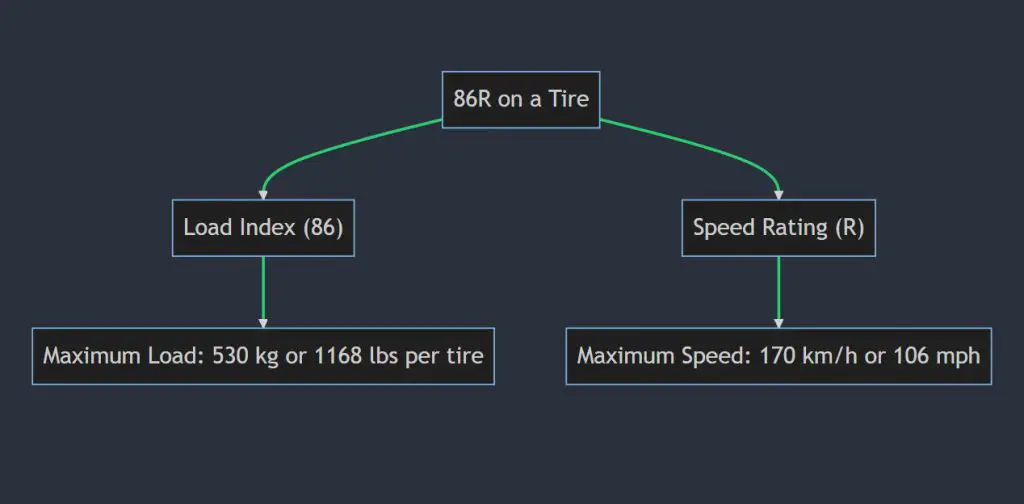
Specifics about 87r Tires
Welcome to the fascinating world of 87r tires – the realm of radial construction and balanced load-bearing prowess!
Typical Use Cases for 87r Tires
87r tires are your daily warrior – whether you’re making that quick run to the grocery store or embarking on a road trip adventure.
Vehicles Suitable for 87r Tires
Given their load capacity, 87r tires commonly find home on compact and mid-size vehicles like the Honda Civic, Toyota Camry, and Nissan Sentra.
Precautions when Using 87r Tires
Remember to regularly check your tire pressure and tread wear. Adhere to the speed rating indicated along with the ’87r’ marking on your tire.
FAQ’s
1. Can 87r tires be used for high-speed driving?
The ‘r’ doesn’t denote speed. Check for the speed rating on your tire’s sidewall.
2. What makes radial tires special?
Radial tires, marked by ‘r,’ offer better handling, fuel efficiency, and ride comfort compared to bias-ply tires.
3. Can I mix radial and bias-ply tires?
It’s generally not recommended due to potential handling issues.
What does 87v mean on a tire?
Your eyes spot ’87v’ on your tire, and you’re intrigued. In the tire code manual, ’87’ is a load index, translating to a max load of 545 kilograms. The ‘v’ is your tire’s speed rating, denoting that it can safely zip along at speeds up to 240 Km/h. It’s like your tire’s own version of a driver’s license!
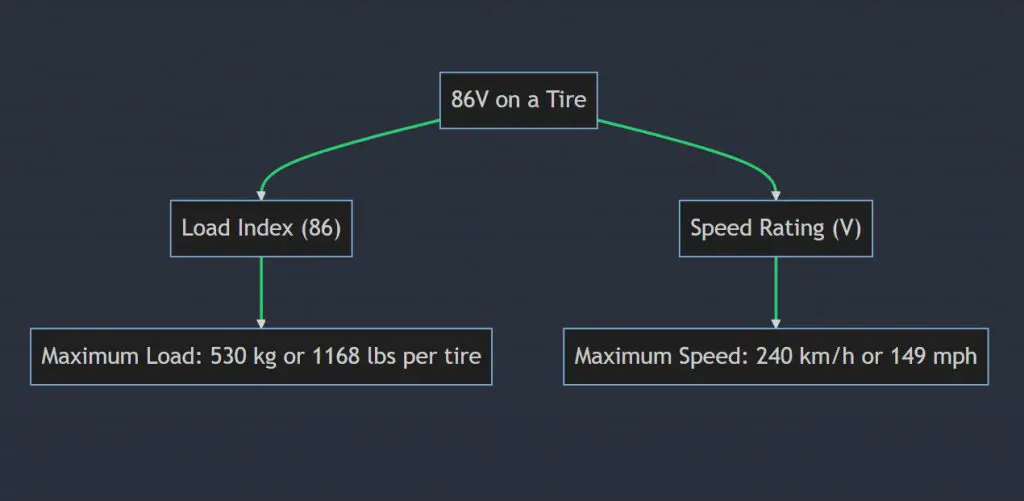
Specifics about 87v Tires
Step into the sphere of 87v tires – where speed and load capacity find a harmonious balance.
Typical Use Cases for 87v Tires
These speed-loving tires are great for highway cruising, urban exploration, and those exciting road trips that leave you craving for more.
Vehicles Suitable for 87v Tires
Given their generous speed rating and load capacity, you’ll find 87v tires on a range of sedans and crossovers like the Audi A4, BMW 3 Series, and Lexus RX.
Precautions when Using 87v Tires
As with any tire, ensure regular checks for tire pressure, alignment, and tread wear.
FAQ’s
1. Can I replace my 87v tires with ones having a lower speed rating?
It’s recommended to stick with the speed rating specified by your vehicle’s manufacturer.
2. What happens if I exceed the speed limit indicated by my tire’s speed rating?
Exceeding the speed limit can cause tire damage and potential safety issues.
3. Are 87v tires more expensive than lower speed-rated tires?
Yes, typically. High-speed-rated tires are often made of higher-quality materials.
What does 87w mean on a tire?
“Hey, do you remember when we used to decode messages in school?” The good old days, right? Well, let’s take a trip down memory lane and decode this tire message ’87w’. In the secret language of tires, ’87’ represents the load index of your tire – it can support a weight of up to 545 kilograms.
Now, the ‘w’ is a speed demon. This letter says that your tire is built to safely reach speeds of up to 270 Km/h. So, next time you see ’87w’ on your tire, give it a high five for its high-speed capability!
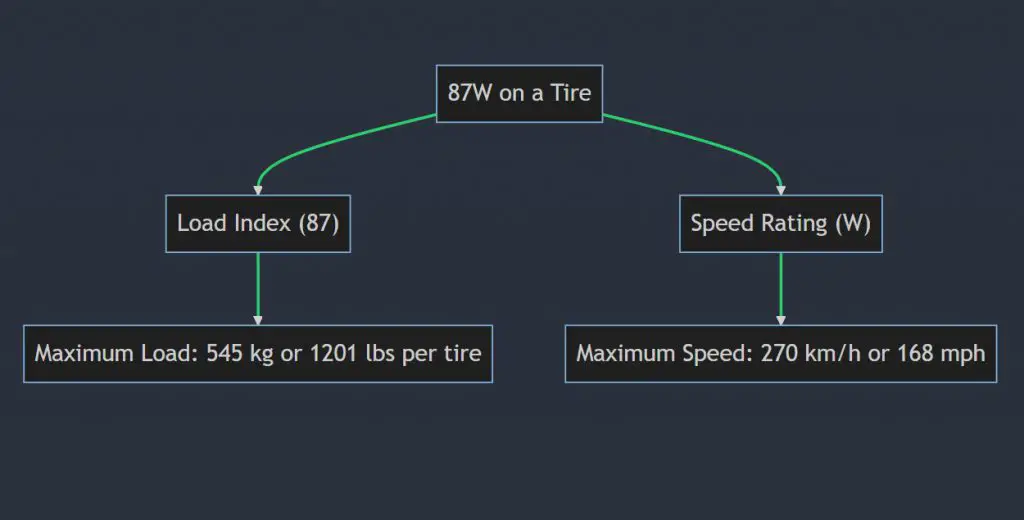
Specifics about 87w Tires
Fasten your seatbelts as we venture into the territory of 87w tires – the realm where robust load capacity meets impressive speed performance.
Typical Use Cases for 87w Tires
With their high-speed rating, 87w tires are primed for the fast lane. They’re great for highway cruising, high-speed driving, and those who just can’t resist the call of the open road.
Vehicles Suitable for 87w Tires
Because of their speed prowess, you’ll find 87w tires on sport sedans and high-performance vehicles like the Mercedes-Benz C-Class, BMW 5 Series, and Audi S4.
Precautions when Using 87w Tires
Always ensure your tires are properly inflated and regularly inspect for signs of wear or damage. Remember, speed should always be in harmony with road conditions and legal limits.
FAQ’s
1. Are 87w tires more prone to wear than lower speed-rated tires?
Not necessarily. Proper maintenance is key to extending your tire’s life.
2. Can I replace 87w tires with a lower speed rating?
It’s not advisable. Your vehicle’s handling and performance might be compromised.
3. Can I exceed the speed indicated by my tire’s speed rating?
Absolutely not! It’s a safety limit, not a challenge.
Recap And Summary
Whether you’re a tire connoisseur or a baffled vehicle owner, knowing how to read your tire’s language is a must. With the various load indexes and speed ratings out there, it might feel like a code only a secret agent could crack. But you’re no less a decipherer now! From the balance of capacity and speed in 87T and 87S, the daily-driver friendliness of 87Q and 87H, the radial reliability of 87R, the speed-enthusiasm of 87V, to the high-speed charm of 87W, you’ve decoded it all. Keep this guide handy, and you’ll be speaking tire fluently in no time.
FAQs
Here we are folks, at the crossroads of tire codes, where decisions are made and questions are asked. But worry not, for I am here to shed some light on these enigmatic markings. Buckle up!
1. 87v vs 87h – What’s the difference?
The difference lies in the speed capabilities. While both share the same load index ’87’, ‘h’ denotes a speed rating up to 210 Km/h, whereas ‘v’ boasts a speed rating up to 240 Km/h. Simply put, if your vehicle and driving needs have a need for speed, 87v might be your tire of choice!
2. 87v vs 87w – Which is faster?
While 87v and 87w tires share the same load index, 87w is the hare in this race. An 87v tire is rated for speeds up to 240 Km/h, while an 87w tire amps it up a notch, rated for speeds up to 270 Km/h.
3. What is the difference between 87t and 87h?
Both 87t and 87h tires can handle the same load, but when it comes to speed, they’re like the tortoise and the hare. The 87t tire is rated for speeds up to 190 Km/h, while the 87h tire takes the lead with a speed rating up to 210 Km/h.
4. 87h vs 87t – Which is better?
The ‘better’ tire really depends on your vehicle, driving style, and needs. If you tend to drive at higher speeds, the 87h tire with its higher speed rating would be more suitable. If you usually drive at moderate speeds, the 87t tire could be a cost-effective choice. Always match your tire’s ratings to your vehicle’s specifications and your personal driving habits!
Final Verdict
When it comes to deciphering tire codes, remember, it’s not about ‘good’ or ‘bad’, ‘better’ or ‘worse’. It’s about understanding what each code means and then choosing the right tire that matches your vehicle’s requirements and your driving style. It’s like finding the right pair of shoes – the most expensive, flashy pair might not be the best choice if all you’re doing is going for a leisurely stroll.
So, next time you’re in the market for new tires, do some detective work. Read those sidewall markings, understand what they mean, and make an informed choice. Here’s to you, the Sherlock Holmes of tire codes! Drive safe and stay awesome!
Alternative Tire Size Codes of Similar Specifications

AR Jeet has been a tire mechanic for over 2years. He has worked on all types of vehicles, from cars and trucks to RVs and ATVs and motorcycles. He has seen it all when it comes to tires, and he knows how to fix them.
AR Jeet is a tire expert, and he is passionate about his work. He loves to help people keep their vehicles running smoothly, and he is always happy to answer any questions that people have about their tires.
If you need help with your tires, or if you just want to learn more about them, then AR Jeet is the man to talk to. He will be happy to help you out, and he will make sure that you get the best possible solution.
He has a blog [Tirespick.com] where he writes about all things tire-related, and he is always happy to help people with their tire needs. Know more about AR Jeet.

